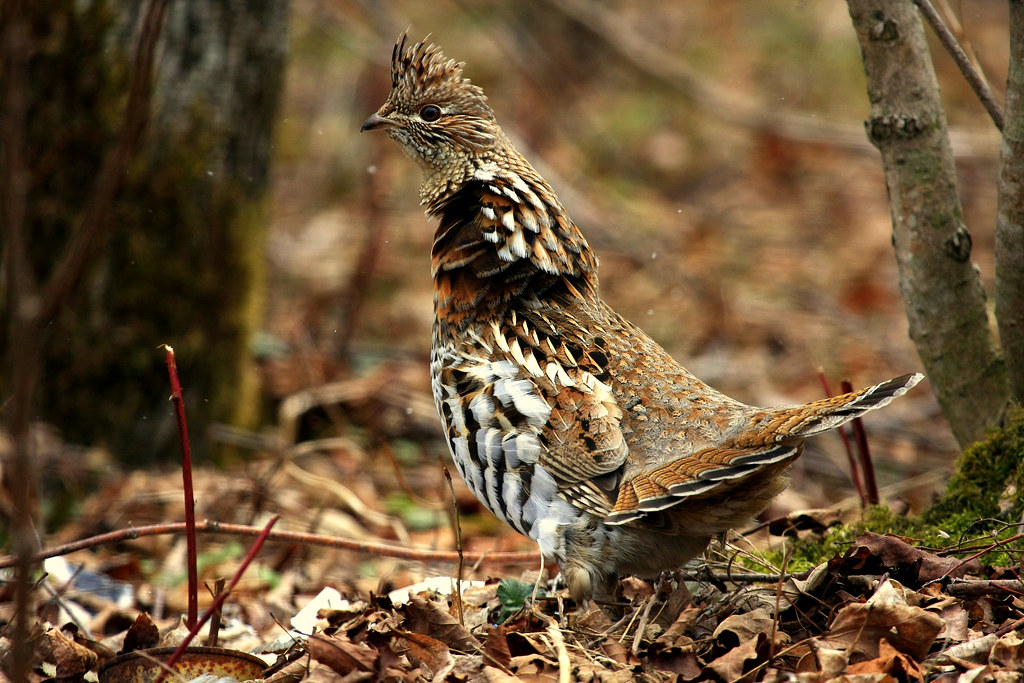Polk County’s Most Wanted – Ruffed Grouse (Bonasa umbelius)
Have you seen…or heard…the Ruffed Grouse (Bonasa umbelius)?

Conserving Carolina and botanist/ecologist David Campbell need your help in locating this month’s “Polk County’s Most Wanted—Animal,” the Ruffed Grouse (Bonasa umbelius). Polk County’s Most Wanted is a community science initiative with a new challenge each month, in which you can expand the scientific understanding of the flora and fauna of Polk County.
Where should I look for Ruffed Grouse?
The Ruffed Grouse is North America’s most widely dispersed upland game bird and the only grouse species that occurs in North Carolina, where they are limited to the western, mountainous counties and a few northern Piedmont counties.
Ruffed Grouse are dependent on early-successional forests for both cover and food. In western North Carolina, they prefer deciduous or mixed forest types with scattered clearings, for instance areas recovering from logging or burning. Their numbers are higher in areas where there has been a disturbance and lower in mature forests.
How do I identify Ruffed Grouse?
This medium-sized bird has dark bars and spotted plumage that allows them to blend into their preferred habitat and remain unseen – until they burst out of the vegetation when you get too close! Ruffed Grouse have two distinct morphs (forms), gray and brown, and can also be a combination of the two, resulting in a tawny brown coloration. The feather pattern is barred or spotted throughout and the head, neck, and back will display the gray, brown, or tawny color. The breast, sides, and belly are mottled with white, and the tail has a broad, black or dark brown band near the end. If you have to opportunity to see the tail fanned out, the male has a solid band near the tip of the tail while the female has a band that is ‘broken’ or washed out looking in the center.
What other clues can I look for when trying to find Ruffed Grouse?
While their plumage makes them difficult to see and find, Ruffed Grouse can more often be heard when they are “drumming,” a sound that many liken to an engine trying to start. This unique drumming display is performed by the male as he stands on a low log, stump, or rock. The bird creates this sound by rotating his wings back and forth, creating a vacuum of air resulting in a slow thumping sound that increases to a rapid crescendo lasting 8-10 seconds. This sound can most often be heard in the morning, but occasionally near dusk and on moonlit nights.
Ruffed Grouse feed almost exclusively on vegetation, such as leaves, buds, and fruits. In the fall, soft fruits and acorns become an important part of their diet. In winter, birds in our region forage on buds, leaves, and the fruit of species like Greenbrier, Mountain Laurel, Christmas Fern, and other green plants.
What can you do?
If you think that you have seen, or heard, Ruffed Grouse in Polk County, please contact Pam Torlina at Conserving Carolina by email at [email protected], and if you can, provide a clear photo or recording, for a definitive confirmation.
For More Information
Visit Conserving Carolina’s website, conservingcarolina.org/polk-most-wanted, for more information about “Polk County’s Most Wanted” and to download and print a “Pocket Guide” with all of the “Most Wanted” plants, animals, and habitats that you can be on the lookout for!
Also, a culmination of David Campbell’s seven years in the field documenting the rare and significant flora and fauna in Polk County have been compiled in a book titled, “An Inventory of the Significant Natural Areas of Polk County, North Carolina.” The document can be downloaded for free on Conserving Carolina’s website at conservingcarolina.org/polk-county-inventory, or a hard copy can be purchased, at cost, on Amazon.
Conserving Carolina, your local land trust, is dedicated to protecting land and water, promoting good stewardship, and creating opportunities for people to enjoy nature. Learn more and become a member at conservingcarolina.org.